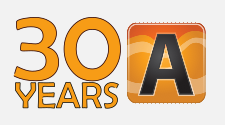
It is now 30 years since the first user requirements document was written for the compartment modelling tool, AMBER. The tool has evolved significantly since then! It now allows users to build and visualise 3D dynamic compartment models of contaminants in environmental, biological and engineered systems. It allows users to simulate contamination from historic, routine, accidental and long-term release situations.
Back in 1993, when Richard Little and Peter Robinson were involved in the specification and implementation of the prototype version of AMBER, it was envisaged that the tool would be used for modelling the migration and fate of radioactive and non-radioactive contaminants in the surface environment (the biosphere). It was decided to use object-oriented programming and the C++ software language to develop the biosphere modelling tool (hence its initial working name, OOBIO) with a graphical user interface that could run on Window 3.1 operating system. Within a short period of time, OOBIO had evolved into AMBER and was being used within the BIOMOVS II international biosphere modelling exercise and in a wide range of countries such as Japan, Spain and the USA. Biosphere-focused applications have since included the modelling of contaminants from routine discharges, accidental and historical contamination and the use of agrochemicals, as well as the fate of contaminants in the human body and coastal and marine environments.
It was soon recognised that AMBER could be extended to represent the near field (i.e. the disposal facility for wastes) and/or the geosphere (i.e. the subsurface through which contaminants might migrate prior to their release into the biosphere). Thus, AMBER could be used to represent the entire disposal system in a consistent and integrated manner thereby facilitating the comparison of disposal concepts and packaging options. The focus was initially on near-surface disposal systems, such as the trench and vault disposal systems assessed in the International Atomic Energy Agency (IAEA) waste activity limits document and the vault safety case in its ISAM programme (Figure 1).

However, AMBER soon started to be applied to a wider range of assessments including the assessment of:
- geological repositories for low and intermediate level radioactive waste (LILW), for example the Canadian Deep Geological Repository, the final repository for LILW at Forsmark (SFR) in Sweden and the Baita Bihor repository in Romania;
- geological disposal of high level waste (HLW) and spent fuel (SF) in countries such as Korea, Lithuania and Sweden;
- borehole disposal of disposal of disused sealed radioactive sources (Figure 2);
- hazardous waste disposal; and
- site-wide, integrated modelling supporting strategic decisions about the decommissioning and closure of nuclear sites.

AMBER has been and continues to be updated and maintained to the latest software standards and new capabilities introduced. In particular, AMBER 6.0 was released in 2015, providing spatial awareness and 3D visualisation of AMBER models, capabilities that are still unparalleled in this calibre of contaminant transport and risk assessment code. Additional features, such as intelligent text input for the building of expressions were also included and further enhancements have been made in the subsequent years including the rendering results in 3D (e.g. contaminant concentrations) which takes visualisation and communication of models to a new level (Figure 3).
Over the past 30 years, AMBER has been used by over 100 organisations in more than 40 countries and continues to be used for a diverse range of purposes. Its use is supported by full suite of documentation, tutorial videos and training courses. Quintessa is fully committed to the long-term development and support of AMBER, with on-going development and annual software updates. Developments planned for the future include the ability to add formal quality assurance checks and comments to case files and continued refinement of the user interface.